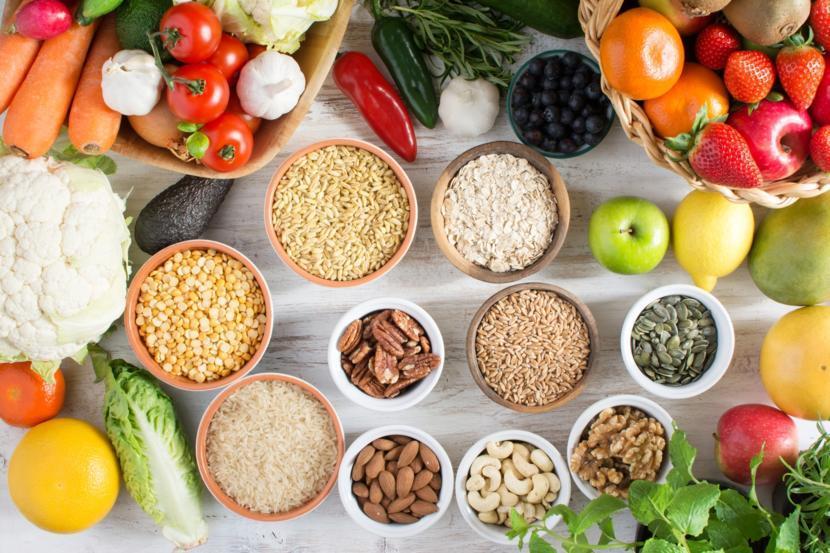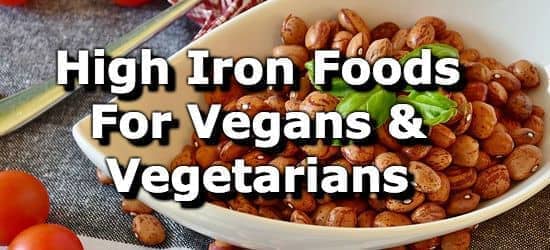High Iron Rich Foods For Vegetarians And Vegans

Let us understand what Iron rich foods is. Though it can be taken as a supplement, enough iron is available in our dietary sources. Vegans can find non-heme iron in dried beans and legumes, dark green leafy vegetables, dried fruits, nuts and seeds, and wholegrain cereals and bread.
Hemoglobin is a protein in red blood cells that carries oxygen from your lungs to all parts of the body. Myoglobin, another protein made of iron, brings oxygen to your muscles.
What is Iron and Why is it Necessary?
Iron is known to be an essential nutrient that plays a vital role in many functions related to the body. An iron-deficient diet can lead to shortness of breath, headaches, low energy levels, dizziness, and anemia.
The recommended daily intake of iron is 18 mg per day on average. Although, this requirement will definitely vary from individual to individual depending upon the age, health condition, gender as well as life stage. For example, adolescent girls need 35mgs of iron to cover growth and menstrual losses whereas a lactating mother needs 21 mg of iron per day.
Iron can be found in two forms when it comes to food, namely heme, and non-heme. Heme iron is primarily found in animal products, whereas non-heme is not properly absorbed by the body and needs vitamin C for optimum absorption.
It is observed that non-heme iron is not easily absorbed by our body as heme iron, thus the RDI for vegetarians and vegans is 1.8 times higher than it is for the meat-eaters. If you are vegetarian and are looking for food rich in iron here are 12 food items that are filled with iron and will fight your iron deficiencies.
How Much Iron Do You Need Per Day?
According to the National Institutes of Health (NIH), here’s how much iron different groups of people need per day:
- Nonpregnant women age 19 to 50 18 milligrams (mg)
- Pregnant Women 27 mg
- For women Age 51 and Older 8 mg
- For men Aged 19 and Older 8 mg
- Infants and Children 7 to 16 mg, depending on age
Avoid Consuming Too Much Iron
The NIH cautions against taking in more than 45 mg of iron per day if you are a teenager or adult and more than 40 mg per day among those aged 13 and younger.
Daily Iron Needs
If you’re a woman between the ages of 19 and 50, you need at least 18 milligrams of iron a day, according to the National Institutes of Health (NIH). Women older than 50, as well as men, need 8 milligrams of iron a day. However, the average woman only gets between 12.6 and 13.5 milligrams of iron per day, while the average man gets between 16.3 and 18.2 milligrams a day from food.
If you regularly don’t get enough iron in your daily diet or through taking supplements, you’re at risk of developing iron deficiency anemia. While mild or moderate anemia might not cause any symptoms, says the National Heart, Lung, and Blood Institute, severe iron-deficiency anemia can cause fatigue, shortness of breath, and chest pain.
9 Iron Rich Foods for Vegetarians
1. Beans and Peas
Other than soybeans and lentils, red kidney beans, white beans, lima beans as well as navy beans are good sources of iron. These beans offer around 4.4-6.6 mg of iron per cup of cooked beans. Along with these beans, chickpeas and black-eyed peas are also rich in iron. They provide around 4.6-5.2 mg per cooked cup. Along with iron, beans, and peas are splendid sources of potassium, manganese, folate, and many other plant compounds that are beneficial for the body. Consuming beans and peas also helps to solve problems related to blood pressure, cholesterol, and blood sugar levels.
2. Lentils
Lentils are rich in iron, protein, and fiber, making them a great addition to a healthful diet. Each cup of cooked lentils contains 6.59 milligrams (mg) of iron and 17.86 grams (g) of protein.
Lentils also contain many other nutrients, including B vitamins, magnesium, potassium, and zinc. Eating lentils on a regular basis reduces the risk of diabetes, obesity, cancer, and heart disease.
3. Tofu/Tempeh
Tofu is a bean curd that manufacturers make by coagulating milk from soybeans. It is popular among vegans and vegetarians as it contains significant amounts of protein, iron, and calcium. A half-cup serving of tofu contains 6.65 mg of iron and about 10 g of protein. Soy products reduce the risk of heart disease, breast cancer, and prostate cancer. Tempeh and natto are other soy products that contain iron and may provide additional health benefits.
4. Garden Cress
The best source of Iron is Garden Cress seeds. Also called Halim, in the form of Halim Water, it is one of the best sources of iron. Lemon is squeezed into it for enhanced Iron absorption. A glass of this Water fulfills 20% of your day’s requirement of Iron.
5. Turmeric powder (Haldi)
Warm Honey Lemon Water with Turmeric is a simple detox solution that can be consumed every day, first thing in the morning. This spice powder found on every kitchen shelf is a boon to ward off fatigue due to iron deficiency.
6. Spinach
Spanish is one of the best iron-rich food. Spinach is low in calories but high in fiber, vitamins, minerals, and antioxidants. One cup of cooked spinach provides 6.43 mg of iron.
Most people find it easy to incorporate more spinach into their diets by sautéing or steaming the vegetable and adding it to soups and stir-fries. Raw spinach can also be an ingredient in smoothies and salads.
7. Pumpkin Seeds May Be Small, But They Have Lots of Iron
Don’t underestimate these crunchy seeds that you start seeing around Halloween. A 1-ounce serving of raw pumpkin seeds without shells has 2.7 mg of iron, per the USDA, providing a good iron source in a variety of dishes. Add the seeds to homemade trail mix or bread or muffin recipes, or use them as a crunchy topping for yogurt, cereal, or salad. You may also try them alone for a quick and healthy snack — 1-ounce packs with 7 grams of protein. Win-win!
8. Green Leafy vegetables
Green leafy vegetables like spinach, kale fenugreek, and lettuce provide 2.5-6 mg of iron which comprises around 14-36% of the RDI. These green veggies are also rich in potassium and sodium which are essential for the growing body.
9. Mushroom
One cup of mushroom contains 2.7 mg of iron and it is suggested to eat oyster and portobello, as they are rich in iron content as compared to other varieties.
6 Iron-Rich Drinks You Should Include In Your Diet Today!
1. Spinach Juice
Spinach is not only replete with iron but it also happens to be a very good source of potassium, magnesium, vitamin C, B6, B2, K, E, carotenoids, and copper. There are very few foods that are as healthy as spinach. You can blend some spinach leaves with apples if the plain taste of spinach is bothering you.
2. Pumpkin Juice
Pumpkin (or sitaphal) is a treasure trove of antioxidants and minerals that could do wonders for your health. Not just the fruit, but even pumpkin seeds are said to be one of the best sources of iron. You can eat pumpkin seeds for snacks or have them in your smoothie bowl. For pumpkin juice, all you need to do is take a blender, blend the pulp, and drink the juice today.
3. Beetroot Juice
This ruby red juice is one healing potion you must not ignore. Enriched with iron and potassium, beetroot juice could do wonders for your blood pressure levels as well.
4. Kiwi fruit smoothie
If you’re feeling green, whip up a batch of kiwi fruit smoothies that contains all fruit and nothing else. Kiwi is the main ingredient, and each medium kiwi will provide 64 mg of vitamin C.
When kiwi is combined with mango, pineapple juice, and banana, the result is a deliciously fruity beverage with even more vitamin C.
Also read: What Are The Health Benefits Of Ginger Tea?
5. Halim Drink
This drink is an easy and tasty way to get an adequate amount of iron using garden cress seeds or Halim. The drink is loaded with iron, folic acid, vitamins C, A, and E, fiber, calcium, and protein.
Recipe: Combine 1 tbsp. Halim, 2 tbsp. lemon juice, 1/2 cup water in a glass bowl, and mix well. Cover the drink with a lid, leave aside for 2 hours, and serve.
We hope you like reading this article about Iron rich foods. If you have any questions or any doubts then write below in the comment box.
